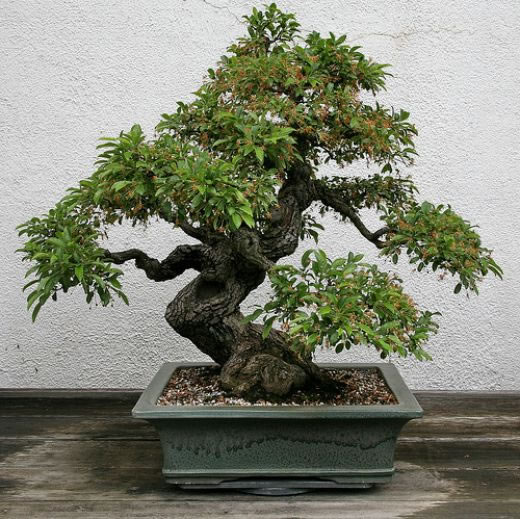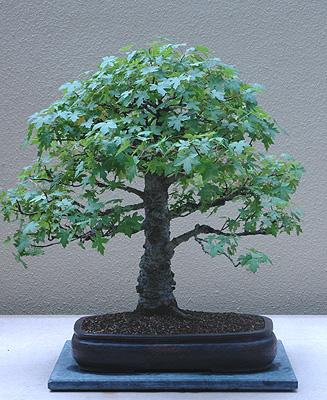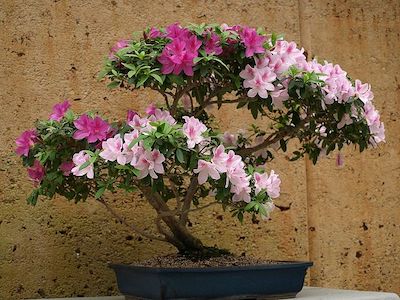Bonsai — Gardening in Miniature
by Carolyn R. Casey, Fairfax Master Gardener
 Having spring wintertime fever? You may have heard of a type of gardening that actually originated in China some 1,200 years ago. Why not try miniature tray plant gardening or bonsai?
Having spring wintertime fever? You may have heard of a type of gardening that actually originated in China some 1,200 years ago. Why not try miniature tray plant gardening or bonsai?
A bonsai plant is really a tree in a pot. Bon means tray and sai means plant. The Japanese translation is “planted in a tray.” The Japanese perfected the art of bonsai during the 13th century. They gathered dwarfed trees that they found growing in nature. These trees were some of the first bonsai. The older trees that the Japanese found in nature appeared aged and graceful with compacted rounded tops and horizontal or drooping branches. At the National Arboretum in Washington, DC, there are some bonsai plants over 300 years old.
There are three different sizes of bonsai trees that range in size from under 5 inches to 30 inches tall. To make the bonsai appear as a mature tree, it needs all parts of the tree to be in proportion. This includes the trunk, branches, leaves, flowers, twigs, fruit, buds and roots.
When choosing a plant to use as a bonsai tree, it needs to have beautiful bark and a trunk that appears mature. The trunk needs to have girth and be in proportion to the whole tree and taper at the top of the tree. The trunk needs a support root at the base that elegantly rises to the top of the tree. The longer and largest branches need to be the lowest branches on the trunk. The rest of the branches need to be successively shorter and have a smaller diameter. Bonsai plants need to have small leaves. The leaves will miniaturize naturally the longer a tree grows in a shallow dish. However, the tree must be a small, leafed tree to begin with. This makes the bonsai tree appear as a mature tree with a natural and unaffected appearance.
There are 10 distinct styles of bonsai. A distinct style is determined by the tree’s shape and how far the trunk slants away from its imaginary axis. The most familiar styles are formal upright, informal upright, slanting, cascade and semi cascade.

Oak bonsai upright
The formal upright style is believed to be a good choice for someone who is just beginning to grow bonsai trees. It is easy to grow since it has a straight trunk, and the lowest bottom branch extends farther from the trunk than the opposite branch.
However, the informal upright style is the best choice when beginning to grow bonsai trees. This style teaches the most about bonsai design. The trunk is upright and curving rather than straight and generally has a zig-zag pyramidal shape. The main branches are at angles where the trunk bends and the apex is aligned over the base of the trunk. The position of the trunk and apex makes the tree asymmetrical.
The slanting style has a trunk that has a more acute angle than the informal upright style. The lowest branch should spread in a direction opposite that in which the tree slants.
The cascade style of bonsai portrays a natural tree growing down the face of an embankment. A cascaded planting usually looks best in a deep round or hexagonal container.
The semi-cascade style has a curving trunk that does not reach the bottom of the pot as in the cascade style. Prostrate junipers (Juniperus) and flowering plants adapt well to this style.
There are many different trees that are considered good choices for the bonsai culture. Dwarf plants, however, do not always convey the same impression as their full-size counterparts because their growth habits are quite different. Some trees and shrubs that work well as bonsai are azalea, beech (Fagus), boxwood (Buxus), ginkgo, oak (Quercus), spruce (Picea), pine (Pinus), zelkova, pomegranate (Punica granatum) and wisteria. Some maple (Acer) and elm (Ulmus) trees are also good choices and respond well to the bonsai culture.

Sweet gum bonsai
Some American gardeners have taken bonsai concepts and applied them to houseplants. By combining traditional procedures for handling houseplants with bonsai concepts of design, growers have created different bonsai styles. There are woody plants native to the tropics and subtropics of the world that are being grown as indoor bonsai.
You can create your own bonsai. Plants for bonsai can be collected from the wild. Be sure to have permission before digging plants on property other than your own, and don’t forget to check the endangered species list for protected plants before you begin. It is not legal to take plants from national parks and other conserved areas.
After the plant is selected, dug and brought home, plant it in a protected area in your garden. Water the plant and feed it sparingly. After one year, it is ready to be placed in a training pot. A light pruning of the branches can take place at potting time, but training should not begin for another year.
All bonsai begin their development in training pots, where they stay until they have a good, fibrous root system and relatively full foliage development which make them look like bonsai rather than just a shrub or tree in a pot. Training pots help trees grown for bonsai make the transition between a deep nursery container, a balled and burlapped root system or landscape, to the shallow confinement of a bonsai pot. During this time, the tree needs to be planted in coarse fast draining soil. A mix of sand, soil and composted bark is a good mix to put around the roots.
Once the bonsai has reached its planned size, it is planted into a complementary pot. The pot needs to complement the style of bonsai you want to achieve. For instance, deep containers are for cascading styles, and shallow, round or rectangular ones are for the upright style.
It is possible to propagate your own bonsai. It is a slow method, but it has the advantage of allowing you to shape the plant from the beginning. Plant the seedling outside, and the trunk will develop quickly. Each year in the spring you will need to dig up the plant and prune its roots. Bonsai can also be started from cuttings.

Semi cascading style azalea bonsai
Bonsai are shaped by pruning, wiring and pinching. Pruning and wiring create the tree’s structure by shaping its woody parts, whereas pinching back the long tips of soft foliage helps side buds to develop, making a branch bushier or twiggier (this is called “ramification”). Pruning is less stressful for the tree than wiring, but both are usually necessary to achieve refinement. Pruning should be done with a concave cutter, a special bonsai tool for making sharp cuts without collars (stubs). All but maintenance pruning should be done at the same time of year as root pruning in order to maintain a supply-and-demand balance between foliage and roots.
Junipers can be repotted at any time during the growing season because they grow throughout it. Pines and other evergreens need to be repotted during the winter before they show signs of new growth. Deciduous trees should be repotted before they leaf out in very early spring. A bonsai that is ready for a bonsai pot should not be transplanted into it until all foliage work (pruning, wiring and pinching) has been completed.
Bonsai trees from the forest need to live outdoors except for being brought inside for two or three hours. Do not bring these bonsai trees inside during the summer unless the interior is well ventilated. During the summer, bonsai need cool nights, sunny days and mist or rain almost daily. If your climate does not offer these conditions, you must supply them. Avoid all extremes in temperature, light, rain and wind. Water the entire plant daily, but do not allow it to become waterlogged. Placing bonsai on a slatted stand in the garden is a good way to help with drainage.
Only apply fertilizer before and during active growth. A houseplant fertilizer diluted from one quarter to one half strength is needed. In the fall, prepare your bonsai for the winter. Slow the growth of the plants by watering less often and discontinuing the fertilizer. Do not prune or cut any branches after mid-August. As with all plants, the bonsai have special needs based on the type of plants they are. Junipers and pines need full sun all day. Maples, elms and boxwoods need morning sun and afternoon shade.
If you are looking to do some gardening this winter that translates into year-round gardening, consider bonsai gardening aka plant in a pot gardening. Happy bonsai gardening.
Resources
The Art of Bonsai, Diane Relf, Dave Close, Virginia Cooperative Extension
Bonsai Styles, Brooklyn Botanic Garden
Growing Trees In (Very) Small Spaces; The Art of Bonsai, Barbara Ott, Butte County Master Gardeners, University of California